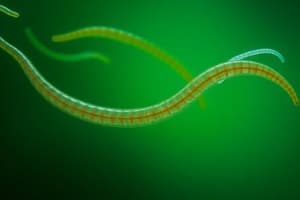Podcast
Questions and Answers
Nematodes comprise the group of organisms containing the largest number of what?
Nematodes comprise the group of organisms containing the largest number of what?
helminth parasites of humans
What are some characteristics of roundworms?
What are some characteristics of roundworms?
They are unsegmented, bilaterally symmetrical, and exhibit great variation in their life cycles.
Nematodes are referred to as roundworms because they are round when viewed in?
Nematodes are referred to as roundworms because they are round when viewed in?
cross-section
The male nematode is usually ________________ than the female nematode.
The male nematode is usually ________________ than the female nematode.
What does the male nematode look like?
What does the male nematode look like?
Generally how long do roundworms live?
Generally how long do roundworms live?
Nematodes have which two stages in their life cycle?
Nematodes have which two stages in their life cycle?
How long can a roundworm be?
How long can a roundworm be?
How do male worms typically appear?
How do male worms typically appear?
The adult anterior end may have what for attachment?
The adult anterior end may have what for attachment?
The outer body surface of a roundworm is a _______________, their ____________ is underneath that.
The outer body surface of a roundworm is a _______________, their ____________ is underneath that.
What organs do male roundworms possess?
What organs do male roundworms possess?
What organs do female roundworms possess?
What organs do female roundworms possess?
Both roundworm sexes have what?
Both roundworm sexes have what?
Who are the definitive hosts for roundworms?
Who are the definitive hosts for roundworms?
What can potentially be the intermediate hosts/vectors for roundworms?
What can potentially be the intermediate hosts/vectors for roundworms?
What do adult female roundworms produce?
What do adult female roundworms produce?
Eggs may be _____________ __________ after ingestion by humans.
Eggs may be _____________ __________ after ingestion by humans.
Eggs or larvae require a period of development in the environment to become?
Eggs or larvae require a period of development in the environment to become?
How are eggs or larvae transmitted to a new host?
How are eggs or larvae transmitted to a new host?
Developing larvae go through a series of 4 molts with the third stage, the filariform larva, most often being the?
Developing larvae go through a series of 4 molts with the third stage, the filariform larva, most often being the?
Infections with roundworms can occur by ingestion of infective eggs or larvae, by?
Infections with roundworms can occur by ingestion of infective eggs or larvae, by?
About one-half of the nematodes parasitic for man are intestinal; the others are found in?
About one-half of the nematodes parasitic for man are intestinal; the others are found in?
What may be the pathogenicity of intestinal nematodes due to?
What may be the pathogenicity of intestinal nematodes due to?
What are filariform larvae?
What are filariform larvae?
What are rhabditiform larvae characterized by?
What are rhabditiform larvae characterized by?
What is the general life cycle of intestinal nematodes?
What is the general life cycle of intestinal nematodes?
Study Notes
Nematodes Overview
- Nematodes are the largest group of helminth parasites affecting humans.
- Roundworms are unsegmented, bilaterally symmetrical, and exhibit diverse life cycles.
Morphology and Anatomy
- Roundworms have a circular cross-section, giving them their name.
- Male nematodes are typically smaller than females.
- Males have a coiled posterior end featuring copulatory spicules and sometimes a bursa.
- Adult nematodes may possess oral hooks, teeth, or plates for attachment in the buccal cavity.
- The outer body is covered by a cuticle, with muscle layers beneath.
Reproductive Structures
- Male roundworms contain testes, vas deferens, seminal vesicle, and ejaculatory duct.
- Female roundworms possess ovaries, oviducts, seminal receptacle, uterus, and vagina.
- Both sexes have a complex nerve cord and a developed digestive system.
Hosts and Lifecycle
- Humans serve as the definitive host for roundworms.
- Arthropods can act as intermediate hosts or vectors; however, many nematodes do not require an intermediate host.
- Female roundworms produce fertilized eggs or larvae that can be infective to new hosts.
Infectivity and Development
- Eggs can be immediately infective upon ingestion by humans.
- Some eggs or larvae require environmental development to become infective.
- Transmission to new hosts occurs primarily through insects.
Infection Dynamics
- Developing larvae undergo four molts, with the third stage (filariform larva) being the infective form.
- Infections can arise from ingestion of infective eggs or larvae, larval skin penetration, or larvae transmitted via insect bites.
- Approximately half of the nematodes parasitizing humans are intestinal; the remainder inhabit various tissues.
Pathogenicity
- The pathogenicity of intestinal nematodes may be linked to:
- Larval migration through tissues.
- Piercing of the intestinal wall.
- Blood loss.
- Allergic reactions to adult or larval secretions.
Larval Types
- Filariform larvae are long and thread-like, specialized for penetration.
- Rhabditiform larvae have a muscular esophagus and bulbular pharynx, emerging from the egg.
Life Cycle of Intestinal Nematodes
- Adult nematodes develop in the intestine after humans ingest infective eggs.
- Exceptions like hookworms and Strongyloides stercoralis involve skin penetration by filariform larvae.
- After hatching in the intestine, adults mature and contribute to a heart-lung cycle before returning to the intestine to mature.
Studying That Suits You
Use AI to generate personalized quizzes and flashcards to suit your learning preferences.
Description
Test your knowledge on Nematodes, the roundworms that are known for being significant helminth parasites of humans. This quiz includes key characteristics and facts about their fascinating life cycles. Perfect for students learning about this diverse and essential group of organisms.




